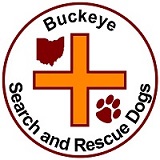
First off, there is really no such thing as a “typical” search dog. but in general, the successful search dog has the physical health and robustness to perform the task asked of them, the drive and focus to persevere in the face of obstacles, and the behavior to be a reliable working dog.
Breed
The simple truth is that many breeds can be trained for at least some aspect of Search and Rescue work.
Over the years BSARD handlers have worked pure- and mixed-breed:
- German Shepherds
- Labrador Retrievers
- Bloodhounds
- Norwegian Elkhounds
- Curly-Coated Retrievers
- Belgian Malinoises
- Newfoundlands
- A Greyhound mix
- A Husky mix
- A Golden Retriever
- A Labradoodle
As soon as someone emphatically states “that breed won’t work,” someone else will come along with a working example to refute the statement. In addition to breeds listed above, we’ve known other handlers that have successfully worked Rottweilers, Australian Cattle Dogs, Vislas, Golden Retrievers, Dachshunds, Russell Terriers, a variety of Mutts and many others (even a Yorkshire Terrier).
With that disclaimer firmly in place, it’s generally accepted that the scent-oriented working and hunting breeds are most commonly used in SAR work. They typically have the size and strength most handlers look for in a SAR dog, especially for rough terrain and/or collapsed structure work. Also, they usually have bigger snouts, which as a result have more scent receptors and turbinates. This means they can move more air through their noses and thus gather more scent than a small-nosed breed such as a pug or bulldog.
Smaller breeds can often excel in those disciplines where physical size and strength are less of a factor, such as water cadaver work (i.e. from a boat) or building searches. In fact, under these circumstances the smaller size can even be an advantage. When BSARD alumni Ed Jagodzinski (then with another team) worked the aftermath of a flood in 1997, he was able to pick K9 Grace up and put her through open windows and the like when other means of ingress were not available.
Finally, pure-breds are more commonly used than mixes and mutts. This is not because they are inherently superior, but just because their genetic history is usually better known and documented, allowing the handler a more reliable expectation of health and temperament.
Keep an open mind about any breed being considered for Search and Rescue, but also be realistic about limitations and expectations.
Personality
The personality of the dog is critical to their performance as a SAR dog. In general, what one looks for in a search dog is:
- A high play drive and an inquisitive nature. Remember that this is all a game to the dog. The easier it is to get the dog “spun up”, the easier it will be to get them to respond to training.
- Self-confidence. The dog has to be willing to take the lead without constantly requiring reassurance from the handler.
- Focus. The dog must not be easily distracted by crossing trails, critters, kids, snacks, or other tempting diversions. Only when the objective is reached can they go back to “being a dog.”
- Obedience. This is defined as the ability to behave and reliably follow commands, but it is not necessary to have Stepford-like obeisance.
- Socialization. A search dog must not exhibit aggressive behavior toward a stranger, whether that stranger is human or canine.
Gender
Nyx and Pearl say girls are better, but Zeke and Dexter insist boys rule.
Since they all perform with a great degree of proficiency and probability of detection, we’re wisely leaving this question unanswered.
